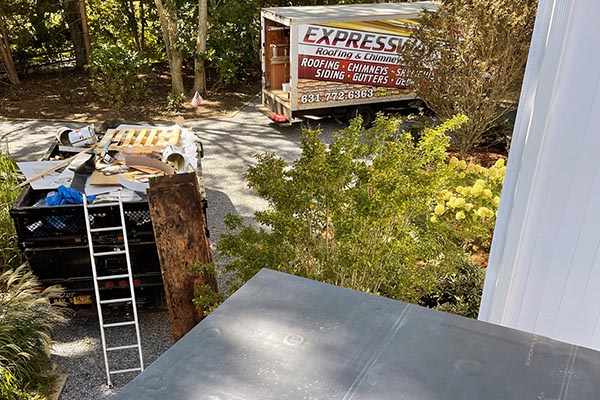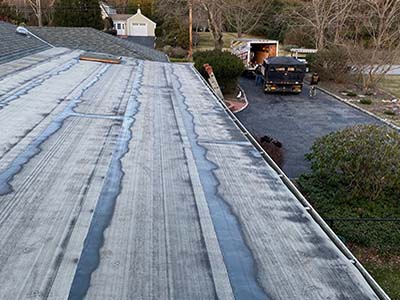
FLAT ROOF MAINTENANCE
FLAT ROOF MAINTENANCE

Roof maintenance is not about our bottom line! It’s really about yours. Like most roofing professionals, Expressway also recommends yearly roof inspections –at least. Regular roofing maintenance and inspections have been proven to increase your roof’s longevity significantly. And by not inspecting your roof you may even void your roof warranty.
The simplest solution is simply to hire a roofing company to inspect your roof for you. But conducting your own inspections has its own advantages. You will almost certainly save money, and you will gain a more intimate understanding of your building that may help you make wiser maintenance decisions in the future.

Ideally, commercial roofs should be inspected before and after severe weather events. Severe weather includes the winter cold of our northern locations and the extreme heat and direct sunlight experienced during our New York summers. Both extremes can weather and damage roofs, so it’s a good idea to prepare for them and to inspect for damage after extreme weather. Roofs should be inspected following severe weather events such as hurricanes, tornados, hailstorms or damaging winds.

If you decide to do your own roofing maintenance, it is critical to develop a checklist to use during inspections. Your roof maintenance checklist will help ensure that you do not overlook any of the elements that require inspection. Your completed checklists will also serve as proof of proper maintenance should you need to submit an insurance or warranty claim. Here are some important elements to include on your checklist:
Interior Signs Of Roof Problems: Before you go to the roof, examine the interior of the building for signs of water damage such as mold, mildew, drips and leaks, water stains, and peeling paint. If you find any, be especially vigilant when you inspect the roof. Be aware that leaks can travel sideways through a building, so the cause of the damage may not be located directly above it. In locations with high snow load or on roofs that carry heavy equipment, you might also want to do an annual inspection of trusses and beams for signs of structural stress like cracking, rot, or rust.
Check for Cleanliness: Once you’re on the rooftop, inspect for accumulated dirt and debris. These can clog drains and cause roofing surfaces to rot or decay prematurely. Fallen tree limbs can damage roof membranes and elements. If you consistently notice fallen branches you may need to schedule tree maintenance as well.
Check the Roof Surface: Look for signs of damage or weathering. On a flat roof, one of the biggest red flags is a low spot that will collect standing water. Make note of any blistering, cracking, tears or holes, abrasions, or deep scratches in the membrane. If it is a gravel-top roof, check to see that the gravel layer is uniform and free of bare spots. For metal roofs, inspect for corrosion and loose or damaged panels. Tile and shingle roofs should be checked for loose, missing or damaged pieces. Make note as well of any fungus or moss growing on the roof. These should be slated for removal as they can deteriorate roof surfaces.
Expansion Joints: If you have these on your roof, inspect them thoroughly for cuts, gaps and tears.
Flashings: If flashing were required to install skylights on your rooftop you need to pay extra attention to these areas! Make sure they are not pulling away from the roof or leaving gaps. This can be an indication that you may have leaking or serious damage to your roof membrane. This should also be a place in which you check for mold.
Drains: Backed up water, moss, watermarks, and mold are all signs of clogged drains. Check also for deteriorated or damaged flashings and seals. These will need immediate attention.
Exterior Structural Components: Elements such as chimneys, vents, pipes, skylights, and equipment should each appear separately on your checklist. Inspect their surfaces for cleanliness, and look for signs of aging such as peeling paint, rust, rot and moss or fungus. Also look for structural damage such as bent elements, missing parts, and sagging pipes.
Pipe and Equipment Supports: One of the most important things on your roof maintenance checklist should be your pipe and equipment supports. Check to be sure that pipes are not sagging, there are no cracks in the base of the support, deflected hangers, or supports digging into the roof membrane. These are all signs that your supports have signs of failing and will need be replaced/repaired soon.
Stairs and Railings: Inspect stairs, crossovers, platforms, and railings for structural soundness, loose parts, surface deterioration such as damaged paint, and for missing or damaged elements such as rail posts and treads. Overlooked issues with these devices can later cause a dangerous and unsafe environment for roofing maintenance professionals.
Safety Signage: Make sure any required signs are legible and posted in a prominent place. Move debris, clean off any accumulated mold or water damage, and replace ruined materials. Especially if there is electrical, harmful chemicals, or extremely hot equipment or pipes on your rooftop. Without the proper signage your repair men could be hurt the next time they are on the rooftop.
Old Repairs: Previous repairs are often the first thing to fail, especially if they were not done by an experienced professional. List each repair separately on your roof maintenance checklist so all future inspectors know what to look for. Double check to make sure the previous issue has been fixed and still working correctly.

Once you have developed a checklist, it helps to have a system to prioritize issues. One simple and effective system is to use a Good-Fair-Poor rating system. A “Good” rating means the element is deemed in good shape and needs no attention beyond routine inspection. “Fair” indicates elements that are showing some wear but have not yet reached a state of emergency. These should be scheduled for maintenance and/or inspection, or be put on the list for future replacement. Items in “Poor” condition—including any issues that involve current or potential water damage—will need immediate attention.
It is also a good idea to decide ahead of time which issues you will be handling in-house and which ones you will call in a professional to address. While doing your own repairs can be cost effective, it is better to err on the side of caution. A compromised roof can result in tremendous structural damage to your building that could eclipse any savings you might realize if you do not have someone on staff who is truly qualified to do the work. Additionally, it helps to have all your warranty information handy to double check what items can and cannot replaced free of charge.
Exactly what to include on your checklist will depend on your unique roof. We recommend starting with the elements listed above, and add or delete items as appropriate for your building. You are certain to find that your checklist is an invaluable tool for proper maintenance of your flat commercial roof.

We are experts at all things ‘flat roof’. We’ve been continuously in business for over 20 years. Some of our other flat roofing services include general flat roof repair, flat roof gutter repair, flat roof chimney repairs and installations and much more. Please call us at 631.772.6363 for your next flat roof repair service.
ASK ABOUT FLAT ROOFING
The Most Dependable & Affordable Residential Flat Roofers On Long Island
 Expressway Roofing & Chimney has all of your commercial and residential flat roof needs covered!
We’re a decades-old, Long Island, family owned and operated all-aspects roofing company that won’t beat around the bush or provide awful customer service. Our free, fair and honest quotes are completely transparent. In fact, our business model has evolved around a concept of fairness, openness and honesty – for our fellow homeowners across Nassau and Suffolk counties. Trust in Expressway Roofing & Chimney – just like our long list of Long Island homeowners that have used our roofing services over the last 20 years.
Expressway Roofing & Chimney has all of your commercial and residential flat roof needs covered!
We’re a decades-old, Long Island, family owned and operated all-aspects roofing company that won’t beat around the bush or provide awful customer service. Our free, fair and honest quotes are completely transparent. In fact, our business model has evolved around a concept of fairness, openness and honesty – for our fellow homeowners across Nassau and Suffolk counties. Trust in Expressway Roofing & Chimney – just like our long list of Long Island homeowners that have used our roofing services over the last 20 years.